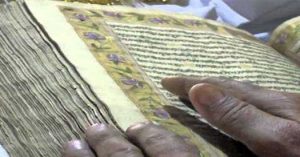The Paath is from Raag Bihagara to Raag Wadhans/Vadhans – Angg 544 till Angg 572.
The Paath starts with a loving exclamation by the jeev isteri. The Love for God is palpable, and the words used by Guru Ji tug at the heart
“O peaceful night, grow longer, I have come to enshrine Love for my Beloved. O peaceful sleep, grow shorter, so I may constantly grasp His Feet (Bani).”
“Vadh sukh rainṛīe paria parem laga. Ghat dukh nīdṛīe parsao sada paga.
ਵਧੁ ਸੁਖੁ ਰੈਨੜੀਏ ਪ੍ਰਿਅ ਪ੍ਰੇਮੁ ਲਗਾ ॥ ਘਟੁ ਦੁਖ ਨੀਦੜੀਏ ਪਰਸਉ ਸਦਾ ਪਗਾ ॥”
In the 2nd Shantt at Angg 545, we listen to Guru Ji’s Ambrosial words say,
Listen O fortunate ones to the Divine Bani of the Lord ; those, in whose destiny it is so written, enshrine such Bani in their hearts.
“Sunn vadhbhagia Har Amrit Bani Ram; jis ko karam likhi tis ridhe samaani Ram.”
ਸੁਣਿ ਵਡਭਾਗੀਆ ਹਰਿ ਅੰਮ੍ਰਿਤ ਬਾਣੀ ਰਾਮ ॥ ਜਿਨ ਕਉ ਕਰਮਿ ਲਿਖੀ ਤਿਸੁ ਰਿਦੈ ਸਮਾਣੀ ਰਾਮ ॥”
The 4th Shantt at Angg 546, starts with a warning to all. As you commit your sins, no friend will come forward to share the burden of your lekhas.
“Paap kamavdeyian tera koye na beli Ram.”
ਪਾਪ ਕਮਾਵਦਿਆ ਤੇਰਾ ਕੋਇ ਨ ਬੇਲੀ ਰਾਮ ॥”
The entire Shantt recounts the miserable life of a manmukh. But Gurbani always ends on a note of optimism. Thus, Guru Ji says, if one takes to Naam, he can be saved.
“Sukh sahaj anand binodh sadh hi Gunn Gopal nit gaavhiye.”
ਸੁਖ ਸਹਜ ਅਨਦ ਬਿਨੋਦ ਸਦ ਹੀ ਗੁਨ ਗੁਪਾਲ ਨਿਤ ਗਾਈਐ ॥”
Shantt no. 5 is in the form of an Ardas, in utter humility.
“Tu Samrath Vada meri matt thori Ram.”
ਤੂ ਸਮਰਥੁ ਸਦਾ ਹਮ ਦੀਨ ਭੇਖਾਰੀ ਰਾਮ ॥”
Shantt no. 6 starts with a stark reminder from the Guru that all we get entangled in, is transitory and perishable. Only Naam is Permanent.
“Binvant Nanak bin Sadhsangam sabh mithiya sansari.”
ਬਿਨਵੰਤ ਨਾਨਕ ਬਿਨੁ ਸਾਧਸੰਗਮ ਸਭ ਮਿਥਿਆ ਸੰਸਾਰੀ ॥੧॥”

In the final pada, Guru Ji speaks of God’s Forgiving Nature.
“Dhar Anugroho Apna kar leena Ram.”
“ਧਾਰਿ ਅਨੁਗ੍ਰਹੋ ਅਪਨਾ ਕਰਿ ਲੀਨਾ ਰਾਮ ॥”
Next comes Bihagde Ki Vaar M.4. It has 21 Pauris and 43 Sloks. The central theme is Guru sewa. It always brings blessings. The Vaar also explores the conduct and miseries faced by those who do not engage in sewa of the Guru (Shabad).
The Vaar starts with a simple, profound reminder.
“Gur sewa te sukh paaiyeh horh the sukh na bhaal.”
“ਗੁਰ ਸੇਵਾ ਤੇ ਸੁਖੁ ਪਾਈਐ ਹੋਰ ਥੈ ਸੁਖੁ ਨ ਭਾਲਿ ॥”
The Vaar discusses various aspects of the lives of manmukhs, who serve their egos (not the Guru), and commit atrocities, which ruin them. The blessed life of the gurmukhs who serve their Guru is highlighted too.
The Pauris are all in Praise of God. He is the Sole Creator, the Only Doer, the Cause and the Event, too.
In Pauri no. 6 at Angg 550, Guru Ji says He is the Field, the Farmer too, and He Himself grows and grinds the corn. He Himself Cooks and puts Food in the dishes, and Himself sits down to eat. He is the Water and He gives the toothpick, and offers the mouthwash. He Himself calls and seats the sanggat and bids them goodbye. On those He chooses to bless with His Mercy, He makes them walk in His Will.
“Aape dharti Aape hai rahak Aap jamaiye pisaavhe; Aap pakavhe Aape bhande de bharose Aape hi beh khaave; Aape jal Aape de chingha Aape chuli bharave; Aape sanggat sadh bahale Aape vidha karavhe; jis nu Kirpal Hove Har Aape tis nu Hukam manaavhe.”
“ਆਪੇ ਧਰਤੀ ਆਪੇ ਹੈ ਰਾਹਕੁ ਆਪਿ ਜੰਮਾਇ ਪੀਸਾਵੈ ॥ ਆਪਿ ਪਕਾਵੈ ਆਪਿ ਭਾਂਡੇ ਦੇਇ ਪਰੋਸੈ ਆਪੇ ਹੀ ਬਹਿ ਖਾਵੈ ॥
ਆਪੇ ਜਲੁ ਆਪੇ ਦੇ ਛਿੰਗਾ ਆਪੇ ਚੁਲੀ ਭਰਾਵੈ ॥ ਆਪੇ ਸੰਗਤਿ ਸਦਿ ਬਹਾਲੈ ਆਪੇ ਵਿਦਾ ਕਰਾਵੈ ॥ ਜਿਸ ਨੋ ਕਿਰਪਾਲੁ ਹੋਵੈ ਹਰਿ ਆਪੇ ਤਿਸ ਨੋ ਹੁਕਮੁ ਮਨਾਵੈ ॥੬॥”
After the Vaar is completed, Bani of Raag Vadhans is read from Angg 557. Guru Amardas Ji gives the definition of a vadhans, a Saintly person, at Angg 585.
“Shabad ratte vadhans hai Sach Naam urh dhaar.”
“ਸਬਦਿ ਰਤੇ ਵਡ ਹੰਸ ਹੈ ਸਚੁ ਨਾਮੁ ਉਰਿ ਧਾਰਿ ॥”
Raag Vadhans starts with 3 Shabads by Guru Nanak Dev Ji. Guru Ji concludes the 1st Shabad by saying, all my doubts and misconceptions can only be cleared if I do Ardas to You, and Sing Your Praises.
“Mann te dhokha ta lehe ja sifatt kari ardas.”
“ਮਨ ਤੇ ਧੋਖਾ ਤਾ ਲਹੈ ਜਾ ਸਿਫਤਿ ਕਰੀ ਅਰਦਾਸਿ ॥੪॥੧॥”
This is followed by 9 Shabads of Guru Amardas Ji, and the final Shabad tells us of the toxic effects of ego. It does not allow Naam to settle within you.
“Haumai Naave naal virodh hai doye na vasse Eik thaaye.”
“ਹਉਮੈ ਨਾਵੈ ਨਾਲਿ ਵਿਰੋਧੁ ਹੈ ਦੁਇ ਨ ਵਸਹਿ ਇਕ ਠਾਇ ॥”
3 Shabads by M.4 Ji follow. In the last line of Shabad no. 3, Guru Ji says Naam leads to Merger.
“Nanak Har Jan Har Eko hoye Har japp Har seti reliaya.”
“ਨਾਨਕ ਹਰਿ ਜਨ ਹਰਿ ਇਕੇ ਹੋਏ ਹਰਿ ਜਪਿ ਹਰਿ ਸੇਤੀ ਰਲਿਆ ॥੬॥੧॥੩॥”
9 Shabads by M.5 Ji come next. The final Shabad at Angg 564, starts with a question.
“Mere antar locha Milan ki Pyare hao kyo payi Gur Puray.”
“ਮੇਰੈ ਅੰਤਰਿ ਲੋਚਾ ਮਿਲਣ ਕੀ ਪਿਆਰੇ ਹਉ ਕਿਉ ਪਾਈ ਗੁਰ ਪੂਰੇ ॥”
The entire Shabad revolves around this poser. It concludes by saying that all Love and Happiness was found in the Guru’s Feet (Bani).
“Jan Nanak Har rang maaniya amali Gur Satgur ke lagh Pairhe.”
“ਜਨ ਨਾਨਕ ਹਰਿ ਰੰਗੁ ਮਾਣਿਆ ਅੰਮਾਲੀ ਗੁਰ ਸਤਿਗੁਰ ਕੈ ਲਗਿ ਪੈਰੇ ॥੫॥੧॥੯॥”
There are 2 Astpadhis by M.3. Ji from Angg 568 till 569.
Guru Nanak Dev Ji has 2 Shantts. The 1st Shantt forcefully tells us it is useless to wash the body clean if your conduct is sinful. Only Truthful conduct can cleanse you.
“Kaiyan kurh vigarh kahe naiyhe; Nata so parvaan Sach kamaiyhe.”
“ਕਾਇਆ ਕੂੜਿ ਵਿਗਾੜਿ ਕਾਹੇ ਨਾਈਐ ॥ ਨਾਤਾ ਸੋ ਪਰਵਾਣੁ ਸਚੁ ਕਮਾਈਐ ॥”
The Paath concludes after 6 Shantts by M.3. Ji.
The final line of the 6th Shantt echoes the definition of a vadhans, a Saintly soul.
“Nanak Jo Naam ratte soyi Mahal paaiyen matt parvaan Sach Sayi.”
“ਨਾਨਕ ਜੋ ਨਾਮਿ ਰਤੇ ਸੇਈ ਮਹਲੁ ਪਾਇਨਿ ਮਤਿ ਪਰਵਾਣੁ ਸਚੁ ਸਾਈ ॥੪॥੬॥”
Gurfateh
Manjeet Singh
August 30, 2023


